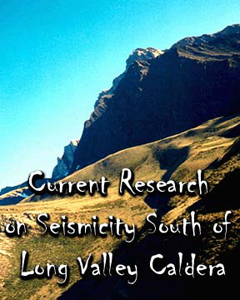
#80FFFF
 |
#80FFFF
|
| This project was inspired by theUC
Berkeley GeologySummer Field course, members
of the UCB Active
Tectonics Group and on going seismic activity
in and around the Long Valley Caldera.
|
|
| Seismicity and Deformation South of the Caldera |
| The
block of Sierrian basement rock south of the Long Valley Caldera, known
here as the Hilton Block, has been host to a barrage of seismic activity
in recent years. Several earthquakes >M6 were recorded in the
H.B. in 1980 and ~M5 quakes are not uncommon, including several in May
of 1999. Much of this activity appears to occur in 3 primary lineations
that run NE-SW at an azimuth of ~20 degrees, and moment tensor solutions
indicate sinistral strike-slip motions. These orientations and motions
appears somewhat anomalous, as most of the mapped faults in the area have
a NW-SE orientation and a combination of dextral and normal dip-slip motions
dominate in the Walker Lane-Eastern California Shear Zone. Regardless,
the area is a complex region, which occupies the interface between the
Long Valley Caldera, Basin and Range extension and The Sierra Nevada Batholith.
The Hilton Block and its episodes are of seismological interest. The area offers a high rate of activity in a highly monitored region, unique moment tensor solutions (non-double-couple, and unexpected sinistral), as well as, some interesting temporal distributions of events relative to caldera inflation. Efforts are currently underway to get high quality 3D locations for all of the events in the area. Determination of moment tensor solutions is also of priority, in order to better understand seismic source mechanisms. As indicated from the preliminary source data, some of the activity in the Hilton Block shows a volumetric expansion and may be due to fluid motions and possible dike injection into the area. Investigations into surficial fault expressions of the seismically active region offers a geologically interesting relationship to the history of the region. Aerial photography of the Hilton Block shows several clear lineations that match the seismic patterns. But, is not clearly understood if we have the reactivation of ancient structures in response to the stresses created by the inflation within the caldera, or the birth of new structural features. If further investigations indicate that the seismicity coincides well with the observed lineations, reactivation will most likely provide the best story. |
|
| Comments or questions VISIT
THE COMMENTS PAGE!!
interesting earthquake web site
|

send money for coffee! Peter Higbee Department of Geology and Geophysics University of California Berkeley Berkeley, CA 94720-4767 phigbee@seismo.berkeley.edu |